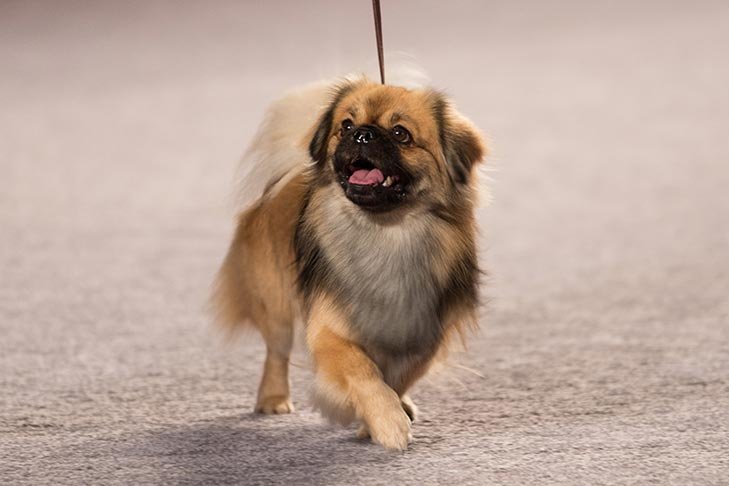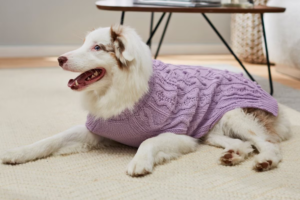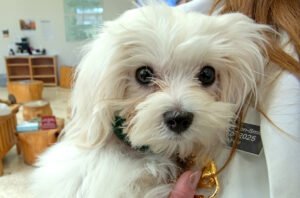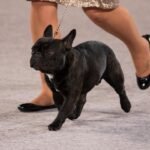When you think of dog shows what most people picture is the sport of conformation. Handlers make conformation look easy, but it actually takes a lot of work to ensure dogs have the right training and skills to do their best when they step into the ring.
In addition to having a dog who is aesthetically a good representation of their breed, if you want to compete in conformation, you and your dog will need to put work into getting ready. Training and conditioning is as important for conformation dogs as it is for dogs participating in any other sport. These training and conditioning skills will help increase your dog’s confidence and support getting them ready for their first show.
Socialization
Some of the most important training you can do with your dog before entering a conformation show is preparing them to feel confident and comfortable in a show venue. Show dogs need to be well-socialized and used to being around new people and dogs. Spend time socializing your dog to a variety of people and dogs so that when they can feel comfortable stepping into a busy show environment.
You’ll also want to introduce your dog to a variety of floor textures, including slippery tile, concrete, matting, carpet, turf, and grass. Introducing these surfaces in advance will help your dog be confident no matter what surface is underfoot at your next show venue. You’ll also want to be sure your dog is socialized to the sensations of grooming and being on a grooming table. To do this, we want to make grooming fun and rewarding for our dogs. Give lots of praise and treats as your dog is getting groomed to help them form positive associations with the experience.

Body Sensitivity Prevention
In order to be successful in conformation, dogs need to be comfortable being handled all over by their handler and the judge. Introducing your dog to being handled as a puppy is key to helping them to mature into a confident show dog. This skill will make sure your dog isn’t nervous being handled while in the ring, which will the judge to get a good look at all areas of their body while they’re stacked for evaluation.
Core Conditioning
Although conformation isn’t a high-impact or particularly strenuous activity, it’s still a sport. Dogs who are competing in conformation need to be in the best physical health as possible. The point of conformation as a sport is to measure how closely dogs correspond to their breed standard, with an eye towards breeding the next generation of puppies to preserve and improve the breed. Core conditioning improves your dog’s posture, movement, and flexibility. This helps your dog to look their best and move more fluidly in the ring, which can help them catch the judge’s eye.
Balance Training

Balance training looks impressive and is also a great way to help your dog build their core strength. You can use canine balance equipment like inflatable exercise discs and wobble boards. As a DIY approach, you can also use pillows to provide a safe but unstable surface for your dog to balance on. Start teaching balance skills by using treats to lure your dog up onto the balance equipment, then praise and treat your dog. As your dog stands on these unstable surfaces, they’re working their core muscles balancing and rebalancing. Once your dog is comfortable standing on the unstable surface, you can start asking your dog to do tricks like “sit,” “wave,” and “spin” on the balance disc. This increases the difficulty as your dog rebalances themselves while moving.
Leash Work
Conformation is a sport that is done on leash. For maneuvering around the show site, you’ll want to make sure that your dog knows how to walk on a loose leash. This will help you to navigate your dog through the show-site. While you want your dog to be loose leash walking outside the ring, we want dogs to be moving with excitement in the ring and looking forward instead of checking in with us. This can be tricky for some dogs, especially if they’ve been frequently rewarded for visual check-ins with their handler. When your dog is moving nicely, toss a treat out in front of them. This can help get your dog’s attention and get them looking forward while in motion.
Body Awareness
Dogs are naturally “front-wheel drive,” which means that, for the most part, where their front feet go, the back feet will follow. As a result, many dogs don’t really think about what they’re doing with their bodies. By working on canine conditioning and body awareness skills, you can improve your dog’s movement, which can help them look better in the ring.
You can also teach your dog targeting, which gives your dog skills to reposition their own body on cue in the ring. To help your dog gain body awareness about where they place their feet, you can work on Cavaletti exercises at home. Cavaletti exercises strengthen your dog’s muscles, improve fluidity of movement, and help keep your dog’s brain active, all of which are helpful for conformation.

Developing a Warm-Up Routine
Show dogs aren’t just pretty faces. Conformation judges are looking at every aspect of a dog’s physical condition when determining who the winning dog will be. While you’ll likely spend extra time grooming your dog so they look their best, you also want to make sure your dogs is awake and feeling their best. An easy way to do this is to develop a warm-up and conditioning routine for your dog. A good warm up routine will help you and your dog connect before you compete, which can help your dog to show their best. A good warm up routine will also help your dog’s muscles to warm up and shake off any stiffness they might have from napping in a crate waiting for ring time. A warm-up routine is a great opportunity to utilize some of the Trick Dog skills your show dog might have to get warmed up.
Spin
Spin is a fun trick that counts towards AKC Trick Dog title and can get your dog moving and warmed up in a small area. You can teach your dog to spin utilizing treats, and then when your dog is good at the trick, you can add this skill into your dog’s routine before going into the ring.
Bow
Another trick that can be used as part of a warm-up routine is the bow trick. Use treats to teach your dog to bow when you’re at home and away from the distractions of the show. Then, once your dog is comfortable with the behavior, you can incorporate curing your dog to bow when you get them out of their crate before going into the ring. The bow skill also helps to stretch your dog’s back and joints.
Walk It Out
At a dog show, don’t wait until right before ring time to get your dog out of their crate. Try to watch the schedule so that you know when your dog is expected in the ring. Then, get them out early and spend some quality time together by taking a walk. Walking helps to warm up your dog’s muscles and gives your dog the opportunity to relieve themselves. Even if your walk is just around the parking lot at the show, getting out and walking can help loosen your dog up, and help them to move better when it’s time to go into the ring.
The post How to Train Your Dog for Conformation appeared first on American Kennel Club.
Visit American Kennel Club at https://www.akc.org/expert-advice/sports/train-your-dog-conformation/







